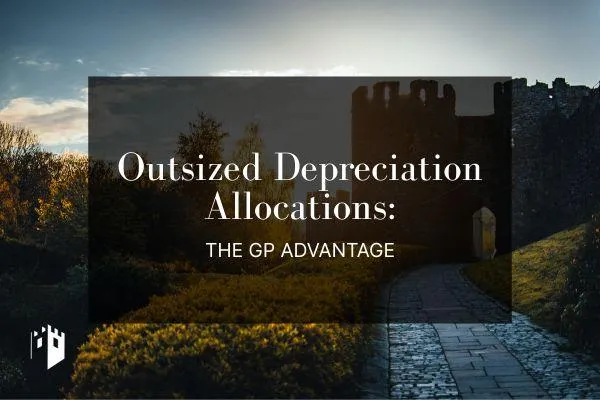From the Vault

Outsized Depreciation Allocations: The GP Advantage
Depreciation is often treated as a passive benefit for LPs. But when structured correctly, it can be one of the most valuable tools for GPs. Sponsors who understand how to capture outsized allocations of depreciation can reduce their personal tax bill, improve investor relations, and enhance fund performance.
Most CPAs miss this. They focus on preparing K-1s, not designing fund documents. That’s why GPs often lose one of the biggest advantages available in the tax code.
How Depreciation Works in Practice
When a fund acquires a property, a cost segregation study breaks the building into components. With bonus depreciation back at 100 percent under the OBBBA, 20 to 30 percent of the purchase price is often deductible in year one.
LPs receive their proportional share.
GPs, however, can be allocated depreciation that reflects their promote, not just their co-invest.
A GP who invested 1 to 5 percent of the equity might still capture 30 percent of the year-one deductions if the fund is structured with a 70/30 split.
This isn’t aggressive. It reflects the economics of the deal and follows the rules under Section 704(b).
Why LPs Often Don’t Use It All
Many LPs — especially high-income W-2 investors — can’t fully utilize real estate losses. Their depreciation allocations often go unused, sitting as suspended losses.
That inefficiency creates an opportunity. By shifting more depreciation to the GP:
The partnership as a whole pays less tax.
LPs still receive strong after-tax returns.
The GP captures real, usable deductions.
It’s a win-win — if the fund is structured correctly.
The Role of Fund Docs and Section 704(b)
Allocating depreciation is not as simple as updating a spreadsheet. It requires:
Properly drafted operating agreements.
Compliance with Section 704(b).
Mechanisms like minimum gain chargeback provisions to withstand IRS scrutiny.
If these elements aren’t in place, the IRS can reallocate losses, leaving both GPs and LPs exposed.
This is where most CPAs fail. They prepare returns but never look at the operating agreement. They don’t coordinate with attorneys. They don’t ensure the economics in the fund documents match the tax allocations.
Why This Matters for GPs
For sponsors, the benefits are significant:
Direct personal tax savings from outsized allocations.
Better investor pitch by explaining how the structure lowers the partnership’s overall tax burden.
Alignment with economics — allocations that reflect the true promote structure of the deal.
Audit readiness — allocations substantiated with legal and tax documentation.
Timing Is Critical
If you’re drafting new fund documents or reviewing existing ones, the time to address depreciation allocations is before year-end. By November, the window for restructuring your 2025 strategy will be closing.
At Stonehan, we’ve reviewed and structured billions in fund documents. We know how to align GP incentives with LP expectations while staying compliant with IRS rules.
Don’t let depreciation flow away from you.
Book Your Tax Strategy Session
⚡ Site Built with BAMF Technology ⚡





